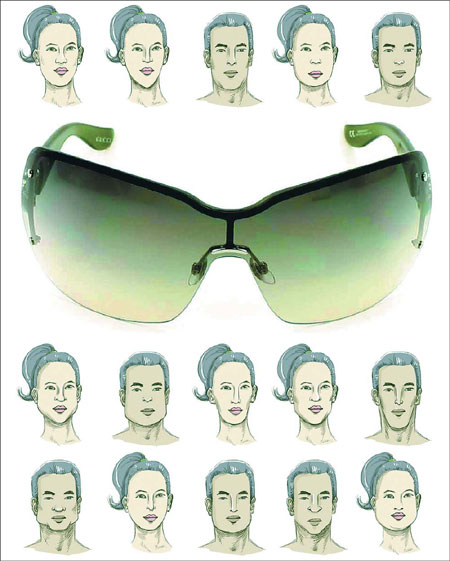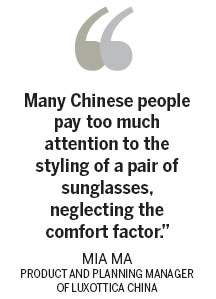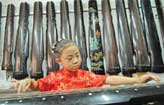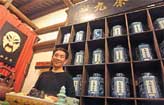Art
Made for China
Updated: 2011-08-02 08:18
By Gan Tian (China Daily)


Chinese faces are different from Westerners and most sunglasses are created according to Western facial features. But help is at hand, Gan Tian finds out.
Beijing offi ce worker Sun Lixiang has looked for but never found a satisfactory pair of sunglasses. Th e fi rst pair she bought, in 2005, was Prada. "Th ey were too big, and kept falling off my face," she complains. So, she bought a smaller pair from Ray-Ban in the summer of 2006, but they hurt her temples, as they were too tight. Just like Sun, many Chinesefashionistas have problems buying a pair of sunglasses that fi t properly. Th ere are plenty of top brands in the Chinese market, such as Oakley and Oliver Peoples, while Gucci, Prada and Louis Vuitton are also making their presence known. But the problem is, all these top-tier sunglasses are designed for Western faces.
Luxottica Group, the Italy-based leading eyewear company that stocks Ray-Ban, Prada and Versace, is addressing this problem by establishing Design Hub, in Shanghai, which specializes in designer eyewear for Asians.
"Chinese faces are different from Westerners and most sunglasses are created according to Western values, so Chinese may find it difficult to get a suitable pair," says Mia Ma, product and planning manager of Luxottica China.
Chinese nose bridges tend to be comparatively short, which was why Sun's Prada kept dropping off.
Second, Chinese generally have wider faces. For typical Chinese women, 51 mm (the usual width of a spectacle frame) is too tight and 53 or 54 mm is more suitable.
Third, a Chinese face has a curved shape, which requires sunglasses around the temple to bend around the head a little more.
Also, the distance between eyes and eyebrows tends to be farther, which means the frames should be higher.
Last, but not least, according to Ma, many Chinese people pay too much attention to the styling of a pair of sunglasses, neglecting the comfort factor.
Eying the huge market here, some international brands have come up with solutions.
In 2009, Ray-Ban and Vogue launched more than 30 optical glasses, designed for Chinese.
Customized sunglasses for Asians were launched in their 2011 spring/summer collections. For the coming 2011-12 autumn/winter collections, more labels are doing the same.
Other labels have developed their own solutions, coming up with "Asian Fitting" versions of their wares.
For example, there are two 12 mm nose pads inserted in Vogue's Asian Fitting versions, which suit short nose bridges.
Meanwhile, Bulgari has announced its high-end eyewear line Le Gemme, decorated with precious gemstones, which has frames that curve better to accommodate Chinese people's relatively high temples.
This is only the first step, according to Luxottica's Ma. The Hub will also develop new products dubbed "Asian Design".
Perry Liu, Taiwan's famous stylist, has been working with Taiwan celebrity sisters Barbie Hsu and Dee Hsu, to develop cool sunglasses.
Before choosing sunglasses, you need to know your head dimensions, particularly eye span, eyebrows, cheekbones and ears.
The three important elements are: style, material and curves.
Darker skin goes well with colored sunglasses, except orange and pink.
If you are using makeup, you need to be careful, as the sunglasses could make your face look "dirty".
The best principle is: Use similar colors. For example, if you wear a pair of brown sunglasses, use some deep colored or brown cosmetics.
Don't choose oversized sunglasses. Asian people have large cheekbones, which do not go well with them.
Finally, don't buy sunglasses from online stores. You need to try them on and then decide.
E-paper

Double vision
Prosperous Hangzhou banks on creative energies to bridge traditional and modern sectors
Minding matters
A touch of glass
No longer going by the book
Specials

Carrier set for maiden voyage
China is refitting an obsolete aircraft carrier bought from Ukraine for research and training purposes.

Pulling heart strings
The 5,000-year-old guqin holds a special place for both european and Chinese music lovers

Fit to a tea
Sixth-generation member of tea family brews up new ideas to modernize a time-honored business
